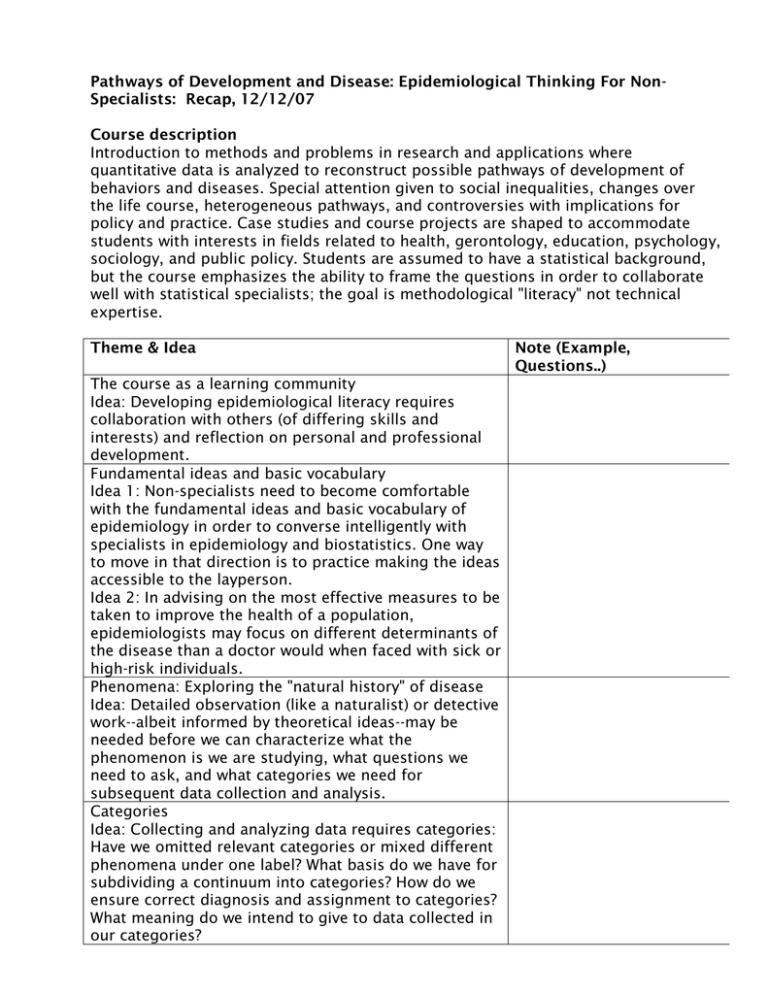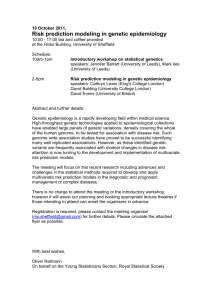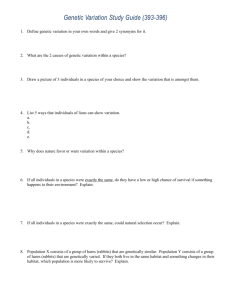week-by-week recap of course
advertisement

Pathways of Development and Disease: Epidemiological Thinking For NonSpecialists: Recap, 12/12/07 Course description Introduction to methods and problems in research and applications where quantitative data is analyzed to reconstruct possible pathways of development of behaviors and diseases. Special attention given to social inequalities, changes over the life course, heterogeneous pathways, and controversies with implications for policy and practice. Case studies and course projects are shaped to accommodate students with interests in fields related to health, gerontology, education, psychology, sociology, and public policy. Students are assumed to have a statistical background, but the course emphasizes the ability to frame the questions in order to collaborate well with statistical specialists; the goal is methodological "literacy" not technical expertise. Theme & Idea The course as a learning community Idea: Developing epidemiological literacy requires collaboration with others (of differing skills and interests) and reflection on personal and professional development. Fundamental ideas and basic vocabulary Idea 1: Non-specialists need to become comfortable with the fundamental ideas and basic vocabulary of epidemiology in order to converse intelligently with specialists in epidemiology and biostatistics. One way to move in that direction is to practice making the ideas accessible to the layperson. Idea 2: In advising on the most effective measures to be taken to improve the health of a population, epidemiologists may focus on different determinants of the disease than a doctor would when faced with sick or high-risk individuals. Phenomena: Exploring the "natural history" of disease Idea: Detailed observation (like a naturalist) or detective work--albeit informed by theoretical ideas--may be needed before we can characterize what the phenomenon is we are studying, what questions we need to ask, and what categories we need for subsequent data collection and analysis. Categories Idea: Collecting and analyzing data requires categories: Have we omitted relevant categories or mixed different phenomena under one label? What basis do we have for subdividing a continuum into categories? How do we ensure correct diagnosis and assignment to categories? What meaning do we intend to give to data collected in our categories? Note (Example, Questions..) Associations, Predictions, Causes, and Interventions Idea: Relationships among associations, predictions, causes, and interventions run through all the cases and controversies in this course. The idea introduced in this session is that epidemiology has two faces: One from which the thinking about associations, predictions, causes, and interventions are allowed to cross-fertilize, and the other from which the distinctions among them are vigorously maintained, as in "Correlation is not causation!" The second face views Randomized Control Trial (RCTs) as the "gold-standard" for testing treatments in medicine. The first face recognizes that many hypotheses about treatment and other interventions emerge from observational studies and often such studies provide the only data we have to work with. What are the shortcomings of observational studies we need to pay attention to (e.g., systematic sampling errors leading to unmeasured confounderssee next class)? Variations in health care (by place, race, class, gender) Idea: Inequalities in how people are treated are associated with place, race, class, gender, even after conditioning on other relevant variables. Heterogeneity within populations and subgroups Idea: How people respond to treatment may vary from one subgroup to another--When is this a matter of chance or of undetected additional variables? How do we delineate the boundaries between subgroups? Placing individuals in a multileveled context Idea: Different or even contradictory associations can be detected at different levels of aggregation (e.g., individual, region, nation), but not all influences can be assigned to properties of the individual—Membership in a larger aggregation can influence outcomes even after conditioning on the attributes of the individuals. Life course epidemiology Idea: How do we identify and disentangle the biological and social factors that build on each other over the life course from gestation through to old age? Multivariable "structural" models of development Idea: Just as standard regression models allow prediction of a dependent variable on the basis of independent variables, structural models can allow a sequence of predictive steps from root ("exogeneous") through to highest-level variables. Although this kind of model seems to illuminate issues about factors that build up over the life course, there are strong criticisms of using such models to make claims about causes. Heritability, heterogeneity, and group differences Idea: As conventionally interpreted, heritability indicates the fraction of variation in a trait associated with "genetic differences." A high value indicates a strong genetic contribution to the trait and "makes the trait a potentially worthwhile candidate for molecular research" that might identify the specific genetic factors involved. I contest the conventional interpretation and contend that there is nothing reliable that anyone can do on the basis of estimates of heritability for human traits. While some have moved their focus to cases in which measurable genetic and environmental factors are involved, others see the need to bring genetics into the explanation of differences among the averages for groups, especially racial groups. Genetic diagnosis, treatment, monitoring, and surveillance Idea: Genetic analysis has begun to identify genetic risk factors. We need to consider the social infrastructure needed to keep track of the genetic and environmental exposures with a view to useful epidemiological analysis and subsequent healthcare measures. Even in cases where the condition has a clear-cut link to a single changed gene and treatment is possible, there is complexity in sustaining that treatment. Popular epidemiology and health-based social movements Idea: The traditional subjects of epidemiology become agents when: a. they draw attention of trained epidemiologists to fine scale patterns of disease in that community and otherwise contribute to initiation and completion of studies; b. their resilience and reorganization of their lives and communities in response to social changes displaces or complements researchers' traditional emphasis on exposures impinging on subjects; and c. when their responses to health risks displays rationalities not taken into account by epidemiologists, health educators, and policy makers.






